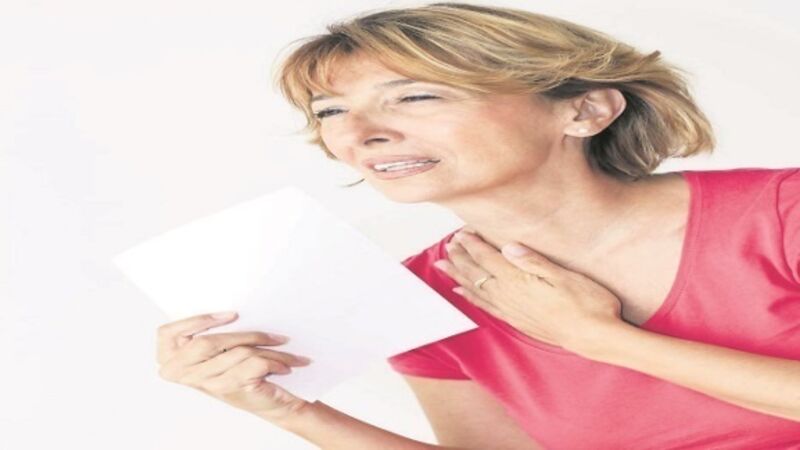Ageing with attitude: Cool solution for a hot topic in middle age

Fancy going to bed with a packet of frozen peas? While your sleeping partner might baulk at the prospect, it could prove the better alternative to throwing all the bed clothes off regularly, or having to change the sheets at an unearthly hour of the night.
Yes, welcome to the world of hot flushes and night sweats, one of the hottest topics covered when women bemoan their menopausal symptoms and arguably the most disruptive of them all, throughout that life transition.
The frozen peas are a tip that dietician and midlife wellness author Paula Mee received from one of her friends, who used to keep the packet behind her pillow and flip it over to offer some cool solace during the night.
But every woman’s experience with that heat rush can be different.
“I was lucky to escape the daytime hot flushes, but I regularly overheated at night. That left me sleep-deprived and pretty irritable. Everyday stuff felt overwhelming,” says Mee, who also covers the subject in her book Your Middle Years, which she co-wrote with lifestyle consultant Kate O’Brien.
“Personally and thankfully my night sweats were not relentless,” she adds. “Bouts of night sweats were followed by bouts of uninterrupted sleep over a two-year period.”
So what is a hot flush in the first place? To use medical jargon it is a vasomotor or blood vessel symptom which means there is an intense build-up of body heat as blood vessels near the surface of the skin dilate, increasing blood flow.
In other words, we heat up internally without any external reason and those telltale red and blotchy patches on our face and neck declare it to the whole world, to make matters worse.
A flush can vary in intensity and duration between 30 seconds and 10 minutes. Some women say they feel a sudden rush of blood from their toes to the top of their head, often followed by a sense of chill.
A hot flush can sometimes cause a rapid or irregular heartbeat and pulse, including heart palpitations and, as well as your skin feeling sweaty you may also feel dizzy, shaky, or have headaches.
But whatever about those uncomfortable daytime experiences, if you suffer from night sweats then the resultant disrupted sleep can seep into every aspect of your life, making you feel vulnerable, anxious and struggling to cope.
It’s no wonder that Eileen Durward, menopause consultant with the natural health remedy company A Vogel, says the issue of hot flushes is the top one raised by the thousands of women seeking advice from her annually.
The experience can definitely vary among women, from minor discomfort to total life disruption, confirms Aisling Grimley, who runs Ireland’s menopause website, My Second Spring.
“On paper, hot flushes seem innocuous enough — a mild sensation of heat can’t be too troublesome, can it?” she says. “But visitors to my website would disagree. While some find hot flushes uncomfortable and inconvenient others find them debilitating.”
Although it’s estimated that three out of four women experience hot flushes, Grimely says 20% of those suffer at the severe end, with quality of life and sleep disrupted. This can last for two years on average, but for 10%, the symptoms can continue to varying degrees for up to 15 years.
“Many report an emotional component to the flushes — as though the heat surge is accompanied by a rush of emotion or mood shift such as anger, frustration, sadness or anxiety,” she says.
Why we all differ in our responses may be somewhat down to lifestyle. The incorporation of relaxation practices such as meditation, movement and deep breathing for instances, may help lower stress triggers and improve overall wellbeing through the hormonal changes.
In fact, a US study last year published in the journal Menopause found that hot flashes and night sweats reduced by over a third in menopausal women who received acupuncture compared with those who did not receive the treatment.
Lead author Nancy Avis said: “Although acupuncture does not work for every woman, our study showed that, on average, it effectively reduced the frequency of hot flashes and results were maintained for six months after the treatments stopped.”
For others, even changing their wardrobe might offer some relief, says Aisling who suggests “seeking out fashion with built in ventilation”, such as cotton and silk, as opposed to polyester and rayon, which will “crank up the heating”.
Avoid identified triggers, in your diet such as sugar, spicy food, strong coffee and alcohol
If you’re on the move, dress in layers but also pack a spare shirt in case you need to change - and a strong deodorant
Make a beeline for a seat near a window or door if possible
Try if you can, to get to bed early to compensate for what hot flush’s nocturnal sister, the night sweat might bring
Abandon your pyjamas or at least wear lightweight cotton or silk versions
Keep cold water and a flask of ice on your bedside
Ultimately, leading a healthy lifestyle should help you cope better with those flushes mentally, physically and emotionally.







